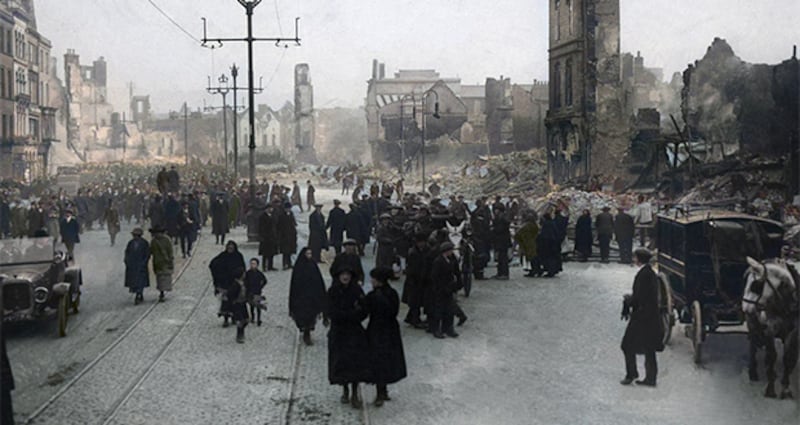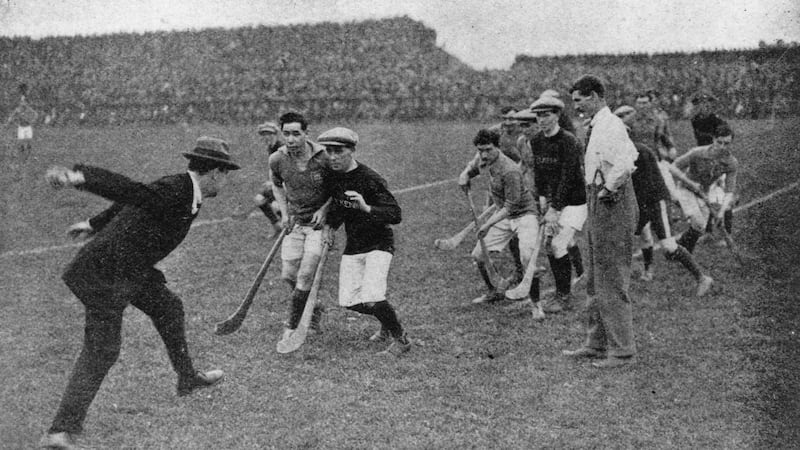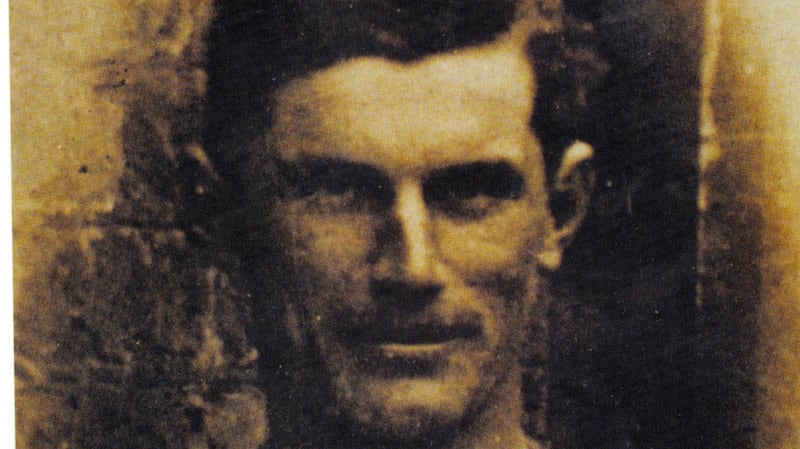By mid-morning on Sunday, November 21st, 1920, the centre of Dublin had plunged headlong into wild chaos. All around Dublin Castle, the traditional seat of British power in Ireland, people were flocking to its gates seeking refuge.
This terror felt like it had been borne across the city by the wind, announced on news boards proclaiming the killing of British spies in their beds across the city by the IRA that morning and amplified by every panicked conversation on the streets and the trams, and in the homes of those employed in any way by the British administration in Ireland.
When every room of the old citadel was full, the iron gates were closed and people shut outside. Some were housed in hotels on Exchequer Street and Parliament Street. Troops were packed into the City Hall next door. Trains and trams had been stopped and checkpoints established to search every other form of transport leaving the city.


Inside the castle, strange, unsettling stories took hold. One officer shot himself in his room having apparently thought he betrayed one victim by revealing his address. Another wounded himself in a cafe on Dame Street and claimed compensation as an IRA victim that morning.
In his office, General Sir Nevil Macready, commander-in-chief of the British forces in Ireland, considered his options. The IRA had struck a severe blow. The initial calls suggested maybe 50 officers dead. Michael Collins’s audacious plans had apparently incinerated the entire British intelligence network, just when its grip was closing round him.
With the city locked down, Macready thought about the football game between Tipperary and Dublin taking place at Croke Park. It seemed feasible that IRA sympathisers with knowledge of the plans that morning and possible combatants might mingle among the huge crowd. Troops were summoned from Collinstown Aerodrome (Dublin Airport). A group of auxiliaries bound for Ashbourne in Meath were gathered into a force of RIC and Black and Tans bound for Croke Park.
Their orders were simple: an officer would enter the field and stop the game with 10 minutes left; the police would perform searches of all the men while the army would form a cordon around the ground to ensure an orderly dispersal of the crowd. The plan guaranteed nothing but chaos.
By the end of that operation, 14 people had been killed or mortally wounded, all orders dissolved by the blind fury that overtook the police. When the first trucks reached the canal bridge overlooking Croke Park, men leapt out and made straight for the ground. Some took positions along the bridge. Sitting in a tree watching the game, 11-year-old William Robinson turned around when he heard the noise of the trucks. The first shot ripped through his shoulder and chest and knocked him out of the tree. The second shot knocked 10-year-old Jerome O’Leary from the wall behind the goals where someone had placed him to get a better view.
Fourteen-year-old John William Scott was so severely wounded in the chest, questions were asked in the House of Commons the following week about whether he had been bayoneted to death
After that, carnage. Firing continued from the bridge. Police climbed over the turnstiles at the corner of the present-day Hogan Stand and Davin End, firing at knots of people trying to escape the field. As the exit gates were crammed with people, an armoured car fired in the air forcing people back inside.
It all took 90 seconds. Fourteen-year-old John William Scott, who lived across the road on Fitzroy Avenue was so severely wounded in the chest, questions were asked in the House of Commons the following week about whether he had been bayoneted to death.
Victims were crushed, impaled and shot even as they left the ground. Jane Boyle was shot and trampled, her hand slipping from her fiance’s as the stampeding crowd swept him away. She was buried in her wedding dress on the same day she was to be married.
In the middle of the chaos Michael Hogan, the Tipperary player, was killed as he crawled towards the sideline seeking shelter. When it was all over, Bill Ryan, one of the Tipperary players corralled by Black and Tans by the railway wall at the Hill 16 end, remembered Jim Egan, another player, wandering back to them having identified Hogan's body, his hands coloured red by Hogan's blood glinting in the late afternoon sun.
Eight of the 14 victims lay in unmarked graves for nearly a century
When it came to explanations, the answers were fudged and forgotten. Two official inquiries declared the first shots had come from inside the ground and were promptly sealed for nearly 90 years. Eight of the 14 victims lay in unmarked graves for nearly a century.
As the truth of their stories fell through the cracks, myth took over. The names of the victims got distorted in the telling. Even the number of victims got understated and overplayed. The challenge match between Dublin and Tipperary was upgraded to an All-Ireland Final. Hogan was a rookie corner-back making his way with Tipp, but got elevated to team captain in the telling.
The GAA itself struggled for decades with the killings in Croke Park. Although the Hogan Stand was dedicated to Mick Hogan in 1926, most of the victims were forgotten as the massacre became the event that sanctified the GAA as the most predominant sporting organisation as the new Free State took shape.
But losing the victims' stories meant losing access to the real complexity of Bloody Sunday. The victims represented a rich mix of Irish life, stretching from the poorest tenements of Dublin to its middle-class suburbs and out into rural life. They were butcher shop workers and bar owners; labourers and bar managers; farmers, van drivers and mechanics. Four IRA volunteers were among those killed, but Michael Feery also died wearing his British army fatigues.

Patrick O'Dowd had lingered on top of the high wall separating Croke Park from the Belvedere College sports grounds as the bullets flew, helping people to the other side. The last man he helped before he was killed was a soldier. When the Black and Tans started kicking Frank "Scout" Butler, the Tipperary goalkeeper, as he lay on the ground, he rolled up his sleeve to reveal a regimental tattoo. Butler had served on the Somme.
In time, the GAA made its own personal peace with Bloody Sunday. Part of that grieving process was achieved through the Bloody Sunday graves project, which offered support to families who wished to erect gravestones on the unmarked plots of their relatives. These were GAA people who went to a match and never came home. A century had passed, but the GAA still owed their families a duty of care.
That gesture alone opened a different outlook and legacy for Bloody Sunday. In August 2016 Nancy Dillon, daughter of James Mathews, laid a wreath at her father’s grave. In November 2015 the family of Jane Boyle gathered from across the globe to unveil a headstone and remember her. Last November, 10-year-old Jerome O’Leary was among three victims who received headstones. He was the youngest victim with no family left. That day, he wasn’t alone anymore. None of them will ever be alone again.
Michael Foley is the author of The Bloodied Field, published by O’Brien Press












